LORD BRAHMA- THE GOD OF CREATION
Contents
- Introduction
- Gods and Goddesses in Sanatana dharma
- The Trimurti or Tridevas
- Lord Brahma – Introduction
- Various Names
- Details of His Origin
- Divine Attributes
- Abode
- Appearance
- Vehicle and Weapons
- Divine Relations
- Life Stories
- Forms and Avatars
- Temples and Festivals
- Modes of Worship
- Brahma Mantras
- Symbolic Significance
- References
Introduction
Sanatana Dharma (सनातन धर्म) or Hindu Dharma (हिन्दू धर्म) is the oldest religion or an idealistic philosophical system that originated and flourished in Bharath Varsha (Bharath or India). Its roots can be traced back to 5000 years during the golden period of Vedas and Upanishads. The word ‘Sanatana’ indicates a timeless, eternal and universal Dharma or religion. It is also known as Vaidika Dharma (वैदिक धर्म) as it is based on Vedas and is proudly acclaimed as the most ancient living religion in the world. Sanatana Dharma is a tradition formed of many streams of thoughts and certain universally accepted codes of conduct. These thoughts and codes are authentic and ancient enough to be described as the foundation of all existing spiritual notions in the world. Hence, Sanatana Dharma is aptly called ‘the cradle of spirituality’.
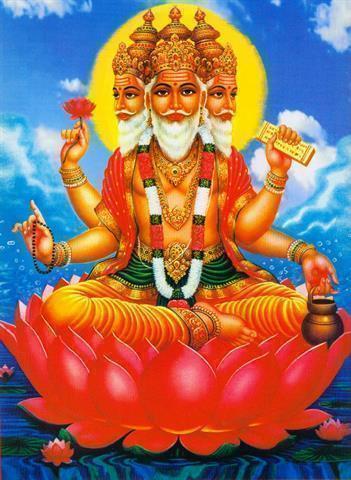
Gods and Goddesses in Sanatana dhama
It is high time the Vedic philosophy reaches every home to save this world from impending destruction. This will also help in the preservation of humanity which is deviating from the noble path and ways of life as prescribed in our age old religious books. The presence of the great phenomenon called ‘God’ is described in many ways in different Vedic manuscripts, but all of them pinpoint to the same ideology as the final note. In the Vedas, the ‘Universal God’ is formless and ineffable ‘Nirguna Brahman’ and Unmoved Mover. As Sankracharya says, “to describe Brahman, even the words recoil.” He can be defined as Omnipresent, Omniscient and Omnipotent whose formless form is posturized in variant forms representing his manifold aspects to be understandable for the normal human sense. Our religion is mainly based on Vedanta philosophy which upholds that what we see is not the reality. Again, this notion is applicable to the ideology of Hindu gods.
Coming to the ordinary layers of human beings, certain doctrines and thoughts always remain complex and obscure for their knowledge. But, this barrier does not exist if one perceives the Hindu dharma as a philosophy rather than a bunch of ordinary ritual and practices. It is an inborn attitude in us that for every concept, concrete or abstract, we attach an image without which it is not possible for us to understand its essence or meaning. How to make us consume the concept of formless presence of god, the omnipotent? This necessity explains the emergence of different forms of gods and goddesses representing various aspects of Brahman in an explicit manner to make it conceivable for normal brains with inquisitive minds.
Though Sanatana Dharma is highly spiritual and philosophical in its roots, its practice has been made easy for the followers who can pursue it in varied faiths and beliefs. Its devotees have the freedom to visualize the Lord in whatever form they like to, and these images are called ‘Murthis’. All these Murthis are quite consistent with the philosophical aspects attributed to them. And thus the ‘Nirguna Brahman’ (Formless god) becomes ‘Saguna Brahman’ through this perspective of god with forms. The word ’idol’ or ‘idol worship’ is a new coinage brought in by western contacts and it has nothing to do with the essence of the age old concept of Murthi worship, which undoubtedly forms the backbone of this great religion. The forms help the Hindu worshippers to pursue easily the incomprehensible Supreme. Thus, Hinduism confirms both form and formless worship of god. Whether one worships in Saguna or Nirguna way, it is ultimately the same god.
The Trimurti or Tridevas
Further to the presence of an omnipotent god Brahman, there is a much vital sankalpa or concept of Trimurti, the trio of important murthis in Sanatana Dharma. The Hindu Trimurti, also called Trinity (meaning three forms), is the representation of the three manifestations of the Supreme Reality, as Brahma, Vishnu and Shiva. This concept is entirely different from the Trinity that exists in other religions. The universal law of the life cycle - creation, existence and destruction - is symbolically defined through these three divine sankalpa. Brahma symbolizes Srishti (creation), Vishnu Sthithy (preservation and renewal), and Shiva Samhara (dissolution or destruction) necessary for recreation. Again, it’s very important to learn that the Hindu Trinity does not compose of three different or independent gods, but three aspects of one Supreme Reality called Brahman by the seers of the Upanishads. They represent the same power (the Supreme Being) but in three different aspects.
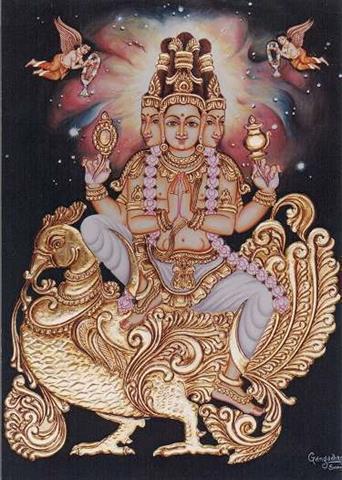
Lord Brahma – Introduction
Lord Brahma –‘ब्रह्मा’ is the first Deva of the Trimurti along with Vishnu and Maheswara (Shiva). Lord Brahma is the originator and the generator of mankind. He is the dhata (the giver), and the Vidhata (the Supreme Being). Brahma is the progenitor or grandsire of humanity and has traditionally been recognized as the creator god. The literal meaning of the word ‘Brahma’ is ‘the truth’. Brahma is the force that keeps everything stable and can be clearly observed in the chemical structure of metals and materials which is required to maintain their equilibrium.
Since the term ‘Brahma’ does not appear in the Vedas, its creation stems from the Sanskrit word ‘Brih’ which means 'to grow’ or ‘to expand’. In this way, it becomes synonymous to Hiranyagharba: The Golden Egg of Creation. The Vedas asserts in Purusha Suktam that three quarters of the universe is indestructible and the remaining one quarter – subjected to the creation and destruction – is what Brahma is connected with.
Brahma worship is an initial step in the evolution of religious concepts and transition from the primitive spirit and hero worship to the concept of divine worship. Brahma worship was at its peak during the composition and writing of Ramayana (ca.300 BC to 200AD). Then Brahma became a fusion of a creator deity with the impersonal absolute Brahman in a more popular and personalized form according to Indology experts. In Hindu mythology the most important form of Lord Brahma is Lord Shiva. Lord Shiva is often referred to as the destroyer, but that destruction is not negative but necessary to preserve the ‘Truth’ and paves the way for rebuilding to occur. The rebuilder is Shiva. Once this rebuilding process is completed one needs to preserve that power, energy and material. The GOD who is the preserver is Vishnu and so BRAHMA, VISHNU and SHIVA are the three forces who are maintaining the universe and the progress of mankind. This can also be regarded as the holy trinity.
Various Names
Brahma, the infinite, source of time, space, causation, forms and names, has a number of significant names.
Om or Aum – ॐ – The Sanskrit name for the syllable is ‘praṇava mantra’ and is described in manifold themes. In Purānic Hinduism, Om is the mystic name for the Hindu Trimurti and represents the union of three gods, viz. A for Brahma, U for Vishnu and M for Mahadev.
Svayambhu – Svayambhu means ‘self-manifested’ or ‘that which is created by its own accord’. Lord Brahma is called Svayambhu as he created himself and was the first one to come into existence as the first differentiated consciousness from the universal consciousness.
Ahankara - Philosophically, Lord Brahma is also considered as the first demonstration of one’s cosmos or creation.
Kanja - It means ‘water born’ and legend has it that he was born in water. That seed was turned into the golden egg and later into the entire Universe of Lord Brahma.
Hiranyagharba - The word can be used as an epithet or alternate name of Brahma. Referred to as the ‘world soul’, Hiranyagharba is the Golden Egg – also called Golden Embryo or Golden Womb – known in the Rig Veda (X.121) as the cause of this universe.
Prajapati - Lord Brahma from the Puranas is called Prajapati in Vedic literature. Prajapati generated creation and created the Vedas to nurture it.
Nabhija - Brahma sprang from Kamala (lotus), from the nabhi (navel) of Vishnu. Hence, he is called Nabhija (navel born).
Chaturanana or Chaturmukha – As he has four faces he is called Chaturanana or Chaturmukha.
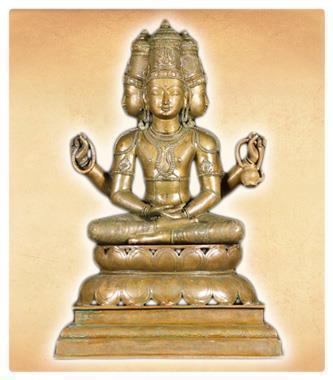
Details of His Origin
Lord Brahma is the god of creation and referred to in many texts as self-born - Svayambhu or unborn - aja. He is not created by anyone as he is self-existent and the first cause of all and existing with his own intrinsic powers.
According to Manu Smriti, a self-existent Supreme once arrived to dispel the darkness from the universe. He produced the waters in the universe and sowed a seed which turned into a golden egg. From the egg, Lord Brahma was born.
Vamanapurana has a different version of the story. It tells that in the very beginning of this universe, nothing but water existed. The germ of living beings amassed into an egg. Brahma, who resided in the egg, went off to sleep in within it. For a thousand of yugas or ages, Brahma slumbered inside the egg. When he woke up, he cut the egg open. From inside the egg, the Omkara (sacred syllable), Om emanated. The three consecutive sounds bhuh, bhuvaha and svaha thus came forth, which later became known as Bhurbhuvaha svaha.
Ramayana says Brahma sprang from atmosphere. The text claims that sages Narada, Sanaka, Angiras, Sanatkumara, Sanasujata, Sanandana, Marichi, Atri and others are Brahma’s ‘manasa putras’.
Another Purana, titled as Devi Purana, states that Brahma sprang from the navel of Lord Vishnu. Lord Vishnu was resting on a banyan leaf, cuddled as a child. He desperately wanted to find out the reason of his creation. Soon a tale unfolded before his eyes where an insight occurred to him revealing that as per the divine protocol he would have to reborn every time a new creation begins.
Devi Purana also vividly defines the padma vidhi or the lotus way episode. It says that once a golden colored lotus grew from Lord Vishnu’s navel, which became the seat of Lord Brahma. In the later part of the text, the whole world is described in parts of the lotus, and Brahma started his creation from this point onward.
Divine Attributes
Hindu deities have unique traits and persona and these qualities are mentioned not only in texts but also depicted in Murthis (idols) of these deities. Pictures of gods and goddesses are portrayed in many different forms, and mostly they are represented symbolically rather than factually. The main aspect of each deity is represented by a unique posture, dress, multiple arms and symbolic objects. It should be noted that a deity representing several different qualities must be portrayed in distinctive forms and ways.
Abode
Brahma's abode is known as Brahmaloka or Sathyalokha comprising of all the grandeurs of earth and of the heavens. It is located on Mt. Meru and also known as Brahmapura. It has been described as avāṅ-manasa-gocara, means something which is beyond the description of words and imaginations of our minds.
The Vedic literatures thus describe Lord Brahma’s abode as:-
yad vai parārdhyaṁ tad upārameṣṭhyaṁ na
yatra śoko na jarā na mṛtyur nārtir na codvegaḥ.
Meaning - In Satyaloka, originated before many billions of years ago, there is no lament, nor is there prime of life, demise, angst or the influence of enemies.
Appearance
Chaturmukhd vedadharah sakshasutra kamandaluh |
Hansarudho raktavasa brahmaloka pitamah ||
Meaning - He has four heads. He holds Vedas, Rosary, Yagyopavita (Sacred thread) and Kamandalu (bowl). He wears red clothes. He also rides a swan. He is none other than Brahma, the grandfather of all.
Kamala (Lotus) - The lotus is a symbol of ‘spontaneous’ generation, and hence it represents divine birth, spiritual growth and creation. It is a symbol of purity and resurrection. Lord Brahma is showed as born from the lotus protruding out of the navel of Lord Vishnu. As a sacred symbol of Hinduism, the lotus is found its mention in all Hindu scriptures. Lotus is the seat of Lord Brahma. Lotus adorns the hand of Vishnu and is a sacred item of worshipping Shiva.
Four heads and faces - In Hinduism, Lord Brahma's four heads represent the four Yugas (cycles of time). The most prominent feature of Brahma’s image is his four faces which symbolically manifest the knowledge of the four Vedas (viz. Rig, Yajur, Sama, and Atharva Veda). Four faces represent that Brahma is the source of all knowledge indispensable for the creation of the universe.
Four hands - Four hands stand for the four directions denoting the omnipresent and omniscient presence of the Lord. Each hand holds certain divine objects denoting fundamental aspects of our lives. In one hand, he holds Vedas denoting the perishability of human bodies and the eternality of the Almighty, Paramatma because every living and non-living particles in this universe are bound to get destroyed at some point. With the rosary in one hand, Brahma teaches us that, we should always keep on chanting the name of Almighty for our welfare, wherever we are. He holds a kamandalu in another hand which stands for renunciation from this world and reminds the need for meditation and deeper concentration. Once we have acquired knowledge we should be poised enough to engage in sacrificial service for the welfare of the world. This is prescribed by the sacrificial implement held in one hand.
White beard and clothes - Brahma has such an eternal existence that his appearance must correspond to his eternity. Hence, Lord Brahma has a white beard as a symbol of wisdom. His white clothes, on the other hand, stand for purity.
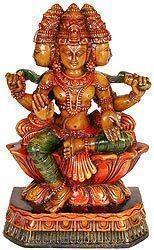
Vehicle and Weapons
As per the Hindu mythology, an exceptional discerning sense of a swan helps it sift pure milk from water. Brahma’s vehicle is also swan for its discerning abilities of sifting good from evil. Unlike other deities, Brahma does not have a weapon. Being the Lord of sacrifices, he is identified with a scepter in the form of a spoon. However, some sources say that Brahma’s weapon is the bow ‘Brahmastra’, which he is sometimes shown with. Sometimes, Brahma is also depicted riding a chariot pulled by seven swans, manifesting the seven worlds.
Duration of Brahma’s Day
His lifetime is described in Bhagavad-Gīta (8.17) as:-
Sahasra-yuga-paryantam ahar yad brahmaṇo viduḥ
Brahma himself is a manifestation of the Absolute. He has a life of 100 years in his time. One day of Brahma is of a duration equivalent to 1000 mahayugas. His night is equally long. At the beginning of each day, creation starts. At the end of the day all that was created merge in the Absolute and Brahma ‘sleeps’ as it were. 360 such days and nights make one year of Brahma. According to the Puranas, he has spent 50 years like this, and this day is the first day in his fifty-first year!
One day is divided into 14 periods. Six such periods are over. We are now in the 7th period. Each period is named after ‘One Ruler’ who is appointed to rule the entire earthly world during that period. The generic name for such a ruler is Manu. The period is called a Manvantara. The name of the present Manu is Vaivasvata, the son of the Sun-God.
Divine Relations
As a universal tradition, Hinduism (Sanatana Dharma) recognizes that the Divine comprises of both feminine and masculine attributes. Recognizing the feminine is necessary to restore wholeness, completeness and universality. Lord Brahma’s consort is Saraswati, the goddess of wisdom and science, mother of the Vedas, and inventor of the Devanagari script. Goddess Saraswati manifested out of Lord Brahma, and all creatures of the world resulted from their union. She is represented as a fair woman who is dressed in white traditional attire. She is depicted with four arms, seated on a white lotus. As the goddess of the arts, she is portrayed playing a veena. In one of her right hands, she holds a book of palm leaves while her other hand adores a lotus. She also holds a string of pearls, and a damaru in her left hands. Brahma and Saraswati represent the Vedas, in their true sense and spirit. Vedas form the genesis of innumerable tales in Hindu literature. All secular and religious knowledge emanates from them. Brahma has two other wives, namely Savitri and Gayatri. All his three wives are described as ‘Mother of Vedas’.
All Hindu gods are regarded as refracted images of Brahma. He created the universe and founded a tradition of teachers. He taught everything he knew to the great sage Narada Muni, who taught it to Vyasadeva, the compiler of the Vedas and Puranas. Brahma created certain ‘beings’ solely by the power of his mind and thought.
Brahmā has nine sons and one daughter born from various parts of his body. They are Agni, Daksha, Dharma, Kama, Anger, Greed, Maya-bheda, Lust and Joy. Angaja is his daughter.
Brahma was assigned the work of creating the universe by Brahman, the Supreme Being. To assist him in this endeavor, Brahma created 10 Prajapatis, who are believed to be the fathers of the human race. Their names, according to Manusmriti are Pulastya, Pulaha, Kratu, Marichi, Atri, Angirasa, Narada, Vasishtha, Prachetas or Daksha, and Bhrigu. These Prajapatis are believed to be born from the mind of Brahma. He is also believed to have created the Saptarishi, or seven great sages, to help him create the universe.
Life Stories
Brahma, the deified hero, generally a forgotten god, has many interesting episodes in the origin and evolution of culture and religious beliefs in the Indian subcontinent. Brahma’s historical depiction in Hindu art and religious texts embraces several interesting legends and interpretations.
Even though Brahma is depicted with four heads facing all four directions, legend has it that formerly he had five heads, the fifth facing upwards. However, originally he is believed to have had just one head. At that time, the universe did not exist, and Brahma was self-content and self-contained. However, he gradually began longing for a suitable company. At this time, he split himself in a female form, named Satarupa (the one with a hundred gorgeous forms). Because of her beauty, he instantly fell for her and longingly stared at her. To avoid his gaze, she moved in all directions. But a head sprang up wherever she moved to enable Brahma staring at her. In desperation, she fled into the air, but a fifth head popped up on top. Shiva observed all that was occurring. Since Satarupa sprang up out of Brahma, Shiva felt Satarupa was just like Brahma’s daughter, and hence it was unlawful for Brahma to be possessed with her. Shiva thus chopped Brahma’s head that looked upwards so she could get rid of him. As punishment for Brahma’s unethical behavior, Shiva curse Brahma pronouncing that there would be no apposite worship of Brahma. Since then, only Shiva and Vishnu are worshipped amongst the Trimurti, while Brahma is almost completely ignored. It is also believed that since this incidence Brahma has been trying to redeem himself of his own sins by ceaselessly reciting all the four Vedas. As per Shiva Purana, the incestuous union of Satarupa and Brahma gave birth to Svayambhu Manu, who eventually became the progenitor of Man.
A couple of reasons are also mentioned in the scriptures describing why Brahma is no longer being worshipped. One belief is that being the creator his work is complete, at least for the time being. Therefore, he is not as revered as the other two gods of the triad. Another reason is based on a legend in the Skanda Purana. In a bid to prove his superiority, Brahma lied to Vishnu and the ketaki flower stood fake witness for him. For this act, Shiva cursed Brahma that he won’t be ever worshipped on earth. Shiva also proclaimed that the ketaki would never be offered in Hindu worship.
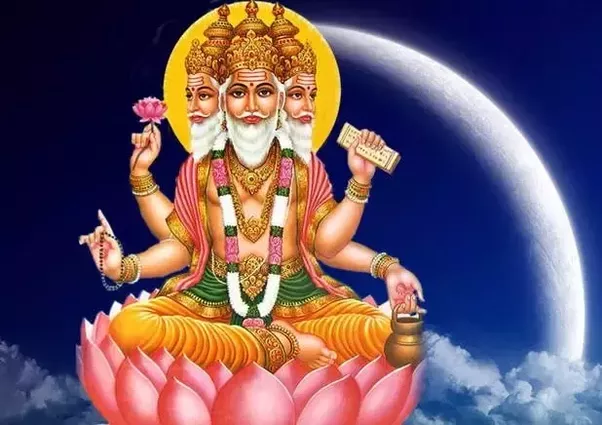
Forms and Avatars
The forms of Lord Brahma:-
- Pitamaha - Patriarch
- Vidhi - Coordinator
- Lokesha - Master of the universe
- Dhatru - Sustainer
- Viswakarma - Architect of the world
The name Narayana was applied to him first and then to Vishnu. Narayana literally means one dwelling in the causal water. The avataras (incarnations) of fish (matsya) and tortoise (koorma) were later called the avataras of Vishnu. The varaha (boar) - to raise the earth from under the waters; create the world, the sages, and prajapatis - was originally attributed to Brahma and later passed on to Vishnu. Brahma produced all knowledge, arts, sciences, dance, music, and drama. He also officiated at the wedding ceremony of Lord Shiva and goddess Parvati.
Temples and Festivals
There are very few temples dedicated to the worship of Lord Brahma. As per the Hindu mythology, various curse supposedly prevented Lord Brahma from being worshipped the way Lord Shiva and Lord Vishnu are worshipped on this earth. Some historians opine that in pre-Vedic Hinduism, a full-fledged Brahma cult existed and was supplanted by Shiva and Vishnu cults in the following centuries.
The most famous temple dedicated to Lord Brahma is located at Jagatpita Brahma Mandir in Pushkar, Rajasthan. Other Lord Brahma temples are Brahma temple at Nerurin in Maharashtra and Thirunavaya Temple in Kerala. The one situated in Aostra village in Rajasthan is also quite famous. Again, Sree Vedanarayana Perumal is also a popular Brahma Temple located in Kumbakonam near Thanjavur, Tamilnadu.
A famous Trimurti temple - where Brahma, Vishnu and Shiva are propitiated – is Sri Arulmigu Magudeshwarar and Veeranarayana Perumaal Temple in Kodumudi.
Brahmapureeswarar Temple in Tirupattur, Tiruchirapalli is another famous ancient shrine devoted to the creator of the universe. Here, the idol of Brahma is fully adorned with turmeric, every morning.
Pushkar Mela (fair), in the ancient Matsya Kingdom Rajasthan, is being celebrated every year since the times of Pandavas and the festival is named after Lord Brahma. It is the biggest camel fair on earth and was initiated to honor Lord Brahma in Rajasthan.
Another most spectacular festival called Tirumala Brahmostsavam is celebrated annually at Sri Venkateswara temple. The festival is so called because it is believed that Lord Brahma himself pays obeisance to Lord Balaji, i.e. Vishnu during the festival. This nine-day Brahmostsavam has its own singularity and grandeur. Millions of devotees converge on Tirumala, during the festival, to witness the lively processions, dazzling lighting, and scintillating music. Devotees especially experience an extremely spiritual ambience that sublimates one’s mind and soul.
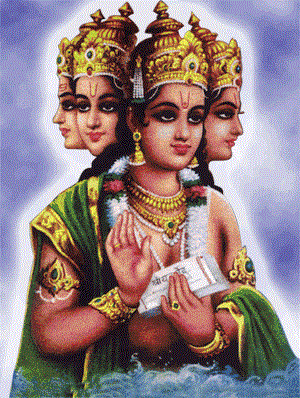
Modes of Worship
Followers of Sanatana Dharma believe that every aspect of life is considered worthwhile to be worshipped. “Let my walking be circumambulation of You,” wrote Shankaracharya. “Let my speech be the recitation of Your holy mantras. When I lie down to sleep, may it be prostrating to You.” Perhaps the most important and pious religious act in Hinduism is puja (worship). It literally means ‘honor’. Practically all Hindu rites involve prayer involving Lord Brahma; yet, very few temples are dedicated to his worship. All creations in the universe emerge out of vikshepa i.e. thought disturbances. This vikshepa-sakti is the embodiment of Lord Brahma – the purest combination of total mind and intellect. Man, who has invoked this vikshepa-sakti has realized Lord Brahma; however, the worship and invocation of Brahma is practiced by few.
Brahma Sampradaya: refers to the disciple succession (sampradaya) of gurus starting with Brahma in Hinduism. The term is most often used to refer to the beliefs and teachings of Madhvacharya and his Dvaita philosophy. Sometimes, it may also refer to the teachings of Chaitanya Mahaprabhu and his Gaudiya theology. Followers of this tradition believe that Vedic knowledge descended from Brahma.
Brahma Mantras
People meditate upon Brahma to attain peace. Brahma Mantra is a crucial part of Brahma meditation.
Om Namo Rajo Jushei Sristau
Sthithou Sattwa Mayayacha
Tamo Mayaya Sam-Harinei
Vishwarupaya Vedhasei
Om Brahmanyei Namaha
(Meaning: Brahma is the creator of the universe. He created the universe with his three nature qualities, positive, negative and dormant. Brahma represents Om, the eternal bliss. Brahma is the supreme god, who brought all things to form. I bow to that divine god Brahma.)
Brahma Gayatri Mantra
Aum Parmeshwaraye Vidmahe
Paratattvaye Dheemahi
Tanno Brahma Prachodayat
Brahma Bija Mantra
Aum Satchit Ekam Brahma
Om Eim Hrim Shrim Klim Sauh Satchid Ekam Brahma
Symbolic Significance
The way Lord Brahma is being defined in Bhagavad-Gita by Lord Krishna will throw light into the concept of Brahma and creation in a more philosophical way. In Bhagavad-Gita, Krishna repeatedly says that “When the yogi realizes that all this existence is just a variegated manifestation of Brahma, he assumes sambhava, and thus he integrates himself with Brahma; he attains the state of Brahma, a state of infinite peace and bliss. Thus, Brahma is not a deity, it is not a god, it is nothing supernatural. Brahma is all that we are, and the abstract cause of all that is, it is a concept which has to be understood, realized and felt, not just to be worshipped.”
Hinduism has represented the god in innumerable forms. Each is an icon that points towards something beyond; but, as none exhausts god's inherent nature, the entire array is needed for a complete picture of god's aspects and manifestations. Lord Brahma is one who gave birth to mankind and hence symbolizes the universe. He is the one who created the mind and the intellect. This is one of the reasons why worship of Brahma is considered so very important. Brahma is the father of all creation and hence by knowing him we gain all knowledge and the essence of knowledge itself.
Several Hindus do not consider their prayers to be complete until they have prayed to Brahma. People, who are seekers of great knowledge and consider it to be their true wealth, worship him. Therefore as his devotees, Brahma has students, scholars, scientists and teachers too. In in Sanskrit, the creative precept of the universe is defined as Brahma. Thai-Buddhist tradition associates Lord Brahma with creation. Brahma is well propitiated in the Indonesian island of Bali, where a substantial number of people practice Agama Hinduism, a particular sect of Hinduism. Here, Brahma is recognized as the first manifestation of the Brahman.
View/s: 20211 Comment/s: 0
